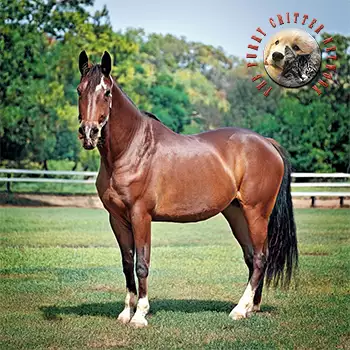General Description
Warmbloods are a group of sport horse breeds and the term simply distinguishes this type of horse from the "cold bloods" (draft horses) and the "hot bloods" (Thoroughbreds and Arabians). Sport horse refers to the intended use of the breed -- as a competitive and recreational horse for the major international equestrian disciplines of dressage, show jumping, eventing and combined driving.
Most warmblood breeds are continuing to evolve. In fact, they are not "breeds" in the sense that Thoroughbreds, Arabians, Morgans and Saddlebreds are breeds. Except for the Trakehner, they do not have closed studbooks. Other breeds are often introduced to the gene pool to reap the benefits of hybrid vigor, and to speed and improve the evolutionary process of attaining the "Breeding Goal" of the particular studbook.
The warmbloods are named for the countries and regions from which they were bred and where the studbooks are kept. The original warmbloods were bred to be an all purpose agricultural, riding, carriage, and cavalry horse. In the twentieth century, the European breeders began refining their horses to produce a large framed, correct horse with superior movement and a willing temperament. The result is apparent in the principal warmbloods which include the Hanoverian, Holsteiner, Trakehner, Oldenburger, Selle Francais, the Dutch, Danish, and Swedish Warmbloods. The main difference in the breeding of warmbloods, is the rigorous documentation, selection and testing for breeding stock. There is mandatory performance testing for all stock with the emphasis placed on temperament and rideability. Although the warmbloods are still capable to be all around horses, they excel in dressage and show jumping.
The Warmblood is more of a "type" than a "breed". Like most of the European warmbloods, the Warmblood has an "open" book. There is more emphasis on producing quality sport horses, rather than the preservation of any particular bloodlines, which allows for much diversity in the bloodlines of Warmbloods
Frame: Harmonious proportions of head and neck, mid section, and hind. Topline - smooth connections, strongly muscled and "uphill" from the dock of the tail to the top of the poll. A well connected and b loin and back. A deep heart girth (distance around the body at the wither). Proper width between the legs. The elbows should be level with the dimple in the stifle. The elbows should be loose and mobile. The frame should be rectangular in shape rather than square.
Head and Neck: Head and neck in proportion to the body. The eyes large and alert. The nostrils large with good air capacity in muzzle area. The neck wedge shaped - the topside of the neck strongly muscled with a gradual and smooth rounding coming out of the wither to the top of the poll without deviations. Supple in the poll (the highest part of the topline (skeletal structure). The bottom side of the neck refined with the attachment above the point of the shoulder rising in a concave arch into the throatlatch. The connection in the jaw and throatlatch unrestricted. The neck set moderately high into the shoulders.
Wither, shoulder, and Forelegs: The wither well defined, with a gradual slope into the back with a moderately good height. The shoulder and humerus should be long and sloping showing a 90 angle from the wither to the point of the shoulder and to the elbow. Displaying prominent depth in the shoulder. Straight and b forelegs, well muscled, twice the length of the short cannon bones. All joints well chiseled and dry. The pasterns moderately sloping and flexible. The hooves b and rounded and always in proportion to the body. The bones strongly chiseled and dry and in proportion to the body.
Back, Hip and Hindlegs: Correct angulation capable of producing propulsion and energy defined by a perfect triangle from the point of the hip to the point of the buttock to the stifle, then back to the hip. A b, powerful rounded croup, with a long muscular structure stretching into the gaskin. The hind limbs straight from the rear view. All joints should be well chiseled and dry. The pasterns moderately sloping and flexible. The hooves b and round and always in proportion to the body. The bones in proportion to the body, b, chiseled and dry.
Walk: Correctness and Purity - Four even beats in length as well as height. Regular and Rhythmical with straight alignment in the fore and hind while in flight.
Walk - Quality: Stepping forward from behind in a generous & athletic way. Creating a swinging momentum throughout the body (elastic & supple). Measurable in the overstride from the hind legs (taking in consideration the length of the back). Freely reaching forward through the shoulders down to the hooves showing articulation in all the joints resulting in a harmonious and balanced walk with a ground covering and marching tempo.
Trot: Correctness and Purity - Two even beats in length as well as height. Regular and rhythmical with straight alignment in the fore and hind legs while in flight.
Trot - Quality: Stepping clearly forward from behind with and "uphill" profile (higher and lighter in the fore than the hind). Elastic and natural engagement with impulsion and showing articulation of the joints. Freedom of the shoulders and haunches with balanced self-carriage. Suspension off the ground. Ideally should round and lengthen on the topline with cresting at the top of the poll. The head reflects the balanced self-carriage of the horse being nearly vertical.






